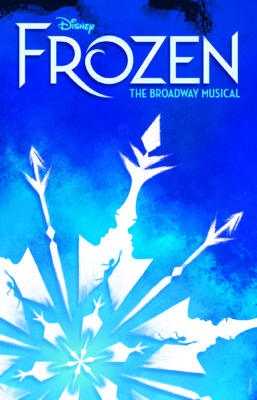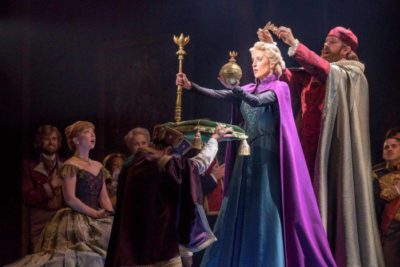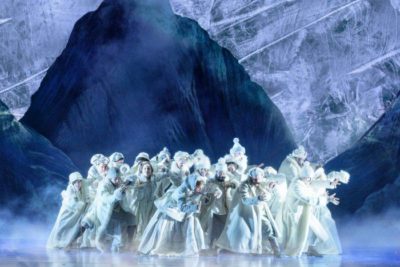 Disney Theatrical’s stage version of Frozen is heading to Broadway next February, but I got a chance to see the pre-Broadway engagement in Denver, Colorado, on September 23rd. The purpose of a pre-Broadway tryout is to give the creative team the chance to test out a new show in front of a real audience and they are constantly making changes to ensure that the final show enjoys a successful run amongst steep competition on the great white way. While the final show is expected to have the same cast, there could potentially be many changes along the way.
Disney Theatrical’s stage version of Frozen is heading to Broadway next February, but I got a chance to see the pre-Broadway engagement in Denver, Colorado, on September 23rd. The purpose of a pre-Broadway tryout is to give the creative team the chance to test out a new show in front of a real audience and they are constantly making changes to ensure that the final show enjoys a successful run amongst steep competition on the great white way. While the final show is expected to have the same cast, there could potentially be many changes along the way.
Seeing the show about a week before the end of its 7-week Denver run increases the likelihood that the version I saw will be close to the final production. One song listed on the show’s Wikipedia page called “When Everything Falls Apart” appears to have already been cut. Translating an animated film to the stage always requires some changes, but Frozen ends up being more of a literal translation.
SPOILER WARNING: If you want to walk into the show fresh, then please stop reading. Below is a list of story changes that include some spoilers.
No Trolls
 Scrolling through the cast list, you will notice Timothy Hughes as Pabbie, Olivia Phillip as Bulda, and that the song “Fixer Upper” is performed by these two characters along with an ensemble of “Hidden Folk.” The Hidden Folk serve the same purpose as the trolls in the film and Pabbie even takes on a narrator role.
Scrolling through the cast list, you will notice Timothy Hughes as Pabbie, Olivia Phillip as Bulda, and that the song “Fixer Upper” is performed by these two characters along with an ensemble of “Hidden Folk.” The Hidden Folk serve the same purpose as the trolls in the film and Pabbie even takes on a narrator role.
At the top of the show when the curtain rises, Pabbie is standing in a giant mossy cloak with a Troll headdress on his head ala The Lion King. As he removes the cloak, he reveals a chiseled bare chest and furry pants with a tail. The Hidden Folk have glowing crystal necklaces like the Trolls in the film and hide in plain sight in the mountains. All of them have dreadlock hair styles (reusing wigs from Tarzan?) and the women are modestly covered while the men bare everything from the hips up. The song “Fixer Upper” also has modified lyrics and a more primitive tempo than the film version.
The Source of Elsa’s Magic
 While the show doesn’t make any profound revelations about how Elsa got her magic powers, it is revealed that her mother, Queen Iduna, is one of the Hidden Folk who left her family and married King Agnarr. When she summons her people to help cure Anna after her head gets frozen, the Hidden People seem to knowingly understand why her child was born with magic powers. Pabbie has no follow-up questions after hearing that Elsa has Hidden Folk DNA within her.
While the show doesn’t make any profound revelations about how Elsa got her magic powers, it is revealed that her mother, Queen Iduna, is one of the Hidden Folk who left her family and married King Agnarr. When she summons her people to help cure Anna after her head gets frozen, the Hidden People seem to knowingly understand why her child was born with magic powers. Pabbie has no follow-up questions after hearing that Elsa has Hidden Folk DNA within her.
Elsa’s Anxiety Over Becoming Queen
One of the lighter changes involves Elsa revealing how anxious she is to become queen through song. In the film, it’s a quick moment where she removes her gloves and hopes her powers don’t show. In the show, Elsa opens up about it through a new tune called “Dangerous to Dream.” The theme is also repeated later in Act II.
No Marshmallow
 Elsa’s giant marshmallow monster doesn’t make an appearance. After Elsa accidentally blasts Anna’s heart and her hair begins to turn white, Kristoff convinces her to leave to seek help from his friends (aka, the Hidden Folk). This is enough for the stage version of Anna to leave her sister after their emotional reunion.
Elsa’s giant marshmallow monster doesn’t make an appearance. After Elsa accidentally blasts Anna’s heart and her hair begins to turn white, Kristoff convinces her to leave to seek help from his friends (aka, the Hidden Folk). This is enough for the stage version of Anna to leave her sister after their emotional reunion.
Other than the Trolls becoming dreadlock mountain people, the other changes seem minor. This is largely due to the fact that both the film and show have a consistent writer in Jennifer Lee. It’s not often that the book to a Broadway show is written by the same person who penned the screenplay. As a film, Frozen felt very theatrical. Its translation to the stage feels like a very natural fit and I hope every fan gets the chance to see it, whether through a trip to New York or on the inevitable national tour.
